According to findings from Ascend2, 62% of marketing professionals see hyper-personalisation as a crucial strategy but only 9% have successfully implemented it. While this comes from a relatively narrow focus group, it’s backed up by the fact that very few of our interactions with brands are personalised at all – let alone enough to get the “hyper” prefix.

Hyper-personalisation is happening, though, and its B2C brands that are pushing the innovation in this department. However B2B marketers should be paying attention here because there’s a genuine risk of being left behind in one of the most important marketing developments in recent years – one that could realise all the promises we’ve been hearing about big data for the past decade.
What is hyper-personalisation?
Hyper-personalisation uses artificial intelligence and big data to create highly-personalised experiences for users. While regular personalisation uses static data to insert users’ names into emails or change landing page content, hyper-personalisation compares your owned data with masses of third-party data to make calculations.
Essentially, AI algorithms compare your users/leads with other online who show the same interests and behaviours. When the right match is made, these algorithms can look at the future actions other users took to predict what your user will react to certain messages.
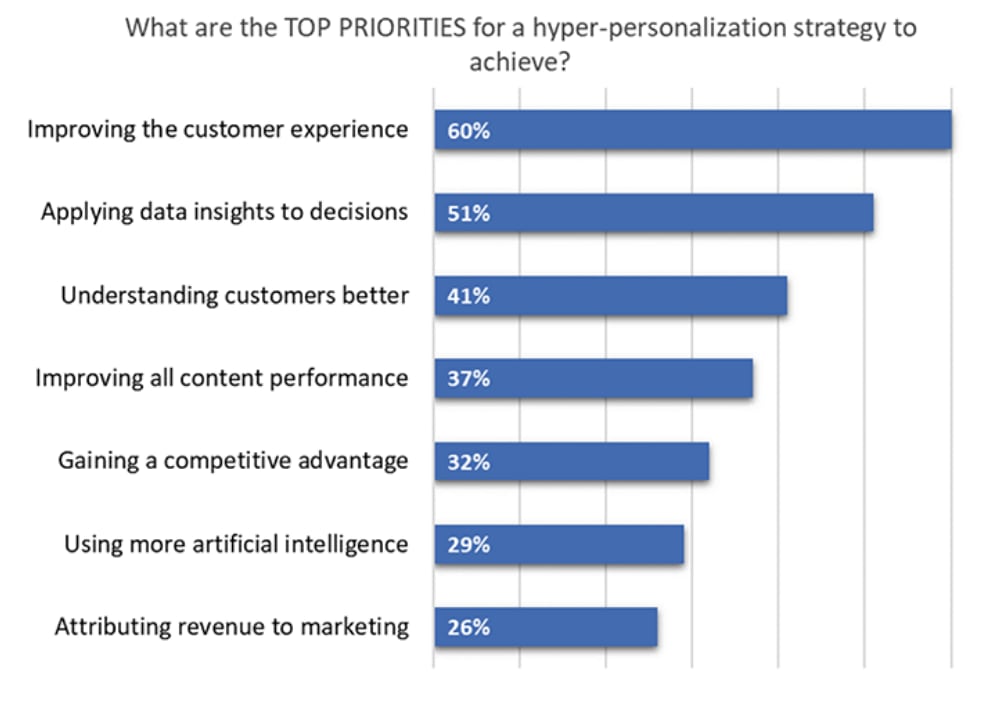
Source: Ascend2
This means you’re able to address user needs with a relatively small amount of data. Better yet, you can address their needs before they even know what they are. This is where the leading B2C brands are leading the way with hyper-personalisation and it’s time for B2B marketers to catch up.
As you’ll see from the examples we’re looking at in this article, hyper-personalisation doesn’t end with the first sale. In fact, this marketing strategy really comes to life once you’ve got customers on board with the first purchase – especially if you have an account-based business structure.
I’ll explain all of this in more detail later. For now, just remember that hyper-personalisation uses AI and big data to enhance your lead generation efforts and it has even more to offer in terms of customers retention and maximising customers value.
What can B2B businesses do with hyper-personalisation?
You only have to look at what today’s most innovative e-commerce brands are doing with hyper-personalisation to see what B2B businesses can achieve with the technology. For some reason, hyper-personalisation hasn’t really broken out of the online retail sector yet, but it’s only a matter of time.
Here are some practical examples of what hyper-personalisation can do for B2B businesses:
- Deliver ultra-relevant offers: First of all, hyper-personalisation allows you to target users with ultra-relevant messages and offers. For example, you can compare customers’ shopping habits with millions of other consumers to make more accurate product recommendations or analyse pre-purchase behaviour to target some users with money-off promotions and others with bulk-purchase discounts.
- Connect with users at every stage of the buying process: By comparing your data with thousands or millions of other users, you can assess how accurate your sales funnels are and pinpoint potential leaks that your own data isn’t comprehensive enough to reveal. With these insights, you can then create highly-relevant messages and automate their delivery to users at each stage of the buying process.
- Predict user actions: By analysing user actions at a mass scale, AI algorithms can predict future actions of other users. Essentially, a certain pattern of actions will point towards a future action – e.g.: when a user looks at a certain combination of product pages, they typically end up buying this product. So, if that’s not the most profitable product they could be buying, what messages can you target them with to upsell them before they even make the purchase?
- Create 100% personalised customer experiences: Hyper-personalisation isn’t just a marketing strategy; it’s a business philosophy and most of the examples we’ll be looking at later have built hyper-personalised products/services from the ground up – and to great effect.
- Maximise customer retention and lifetime value: This is where hyper-personalisation generally has the most impact. By creating highly-personal experiences for individual customers, you’re going get better results from cross-selling and upselling campaigns, resulting in ongoing purchases and increased customer value.
- Build brand loyalty: the more personal your customer experience becomes, the stronger your relationship with each of them will be. Address their concerns on an individual basis and they’re going to feel so valued that it’s difficult to imagine doing business elsewhere. What you’re also going to do is increase each customer’s investment in your brand (money, time, data, etc.), which effectively locks them into doing business with you (and not running off to your competitors).
Those are the key use cases of hyper-personalisation we’re looking at in this article and the best way to explain these in more depth is by looking at examples.
Examples of hyper-personalisation in action
There are a number of B2C businesses – particularly in the e-commerce sector – that are showing that hyper-personalisation can achieve. These principles shouldn’t be restricted to consumer-orientated business, though. B2B brands have just as much to gain from hyper-personalisation (and gain from these examples).
#1: Product recommendations
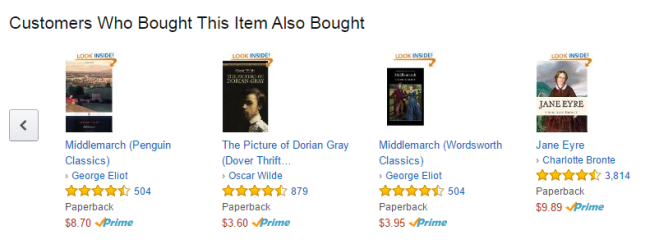
The most common example of hyper-personalisation is product recommendations – the kind of thing you see on Amazon.
These are delivered by AI recommendation engines that analyse mass consumer data to spot purchase trends and offer recommendations based on what people with similar interests have bought.
It’s basically an AI upgrade to related products, except the recommendations are based on human interests rather than simply prompting people to buy similar products.
You’ll also find similar engines used on platforms like Netflix and Spotify as they offer content recommendations to users.
Why does this work?
Instead of simply making recommendations to users based on their own purchase history, artificial intelligence compares their histories to millions of other buyers to find more advanced purchase habits.
Above all, this means more accurate recommendations. But the other key thing is you can use these engines to target customers, even when their purchase history is relatively short, which would otherwise make it impossible to target them with relevant recommendations.
What can B2B brands learn from this?
B2B e-commerce brands can basically copy and paste this strategy into their own sales process. However, service-orientated business can take the same approach to target customers with additional service recommendations, as long as the relevant third-party data is accessible.
#2: User account customisation
Spotify’s music recommends are designed to keep users engaged with the platform and consuming content but this isn’t the only way it uses hyper-personalisation. In fact, I would argue the streaming app’s most effective use of the technology lies in the extensive user account customisation that’s made possible.
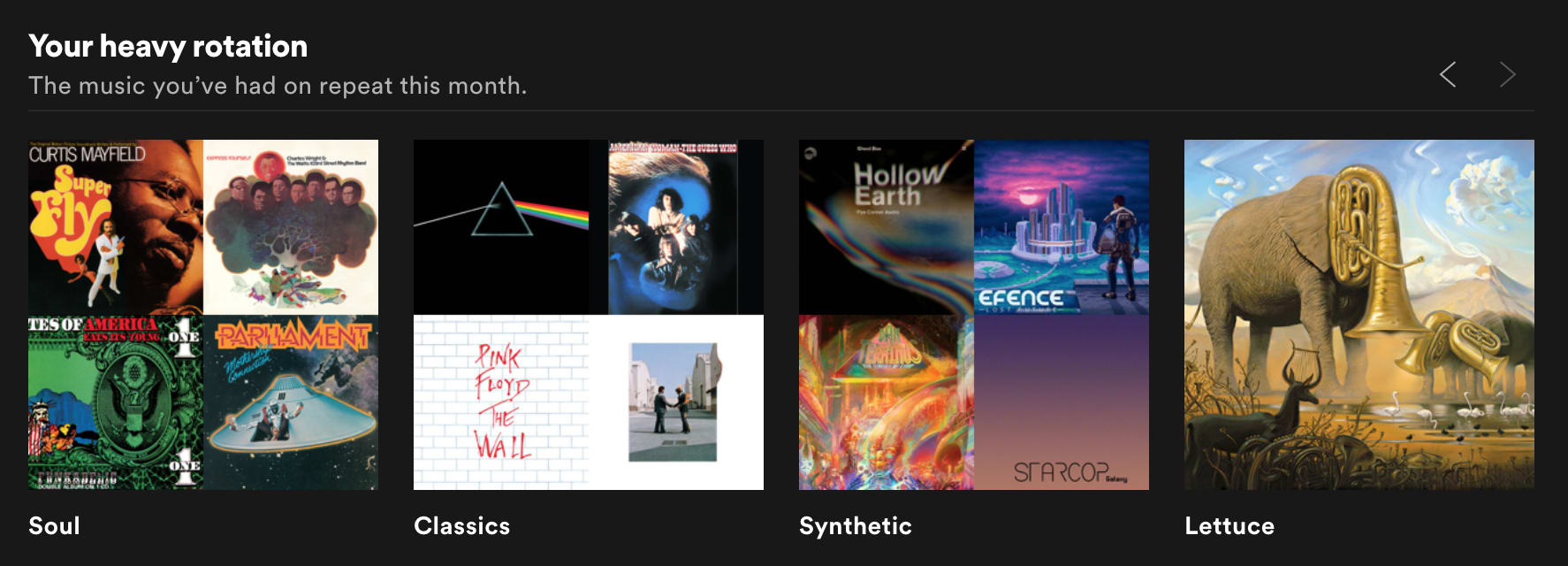
Spotify encourages users to create their own playlists, essentially building an entire library of music on their account. Over the past ten years or so, I’ve gradually created hundreds of playlists with thousands of tracks assigned to my account – I couldn’t even guess what the actual numbers would be.
Why does this matter?
Because I can’t image the prospect of ditching Spotify and recreating those playlists on another platform (or losing them altogether). I’ve invested way too much time into Spotify and, as a result, I’m locked into paying for a premium account – quite happily, too.
Another form of hyper-personalisation that achieves this is cross-platform syncing. The best example I can think of is Google where all of my online activity synced between Chrome on different devices, allowing me to access everything I need at any time, on any device.
Sure, I want to punch myself for giving Google all that data but it’s just too damn useful for me to consider switching synchronisation off, let alone switch to another browser.
Why does this work?
The more users customise a piece of software, the more personal the experience becomes – an experience that’s difficult to find or recreate elsewhere.
The other key factor here is the amlint of time it can take for users to build their own personalised experience. Ideally, this will happened gradually over time so customisation doesn’t get in the way of actually using a platform. However, this time all adds up and a few minutes each day eventually becomes hours (or even days’) worth of customisation that nobody is going to want to lose or repeat elsewhere.
What can B2B brands learn from this?
Any B2B software provider can take notes from the likes of Spotify. The key thing is to make customisation an intuitive part of using the software. Far too many software companies implement customisation in a way that prevents customers from being able to use their platform before things are set up.
Design an experience that encourages gradual customisation and you’ll lock users into your platform for the long haul.
#3: Building personalised customer experiences from the ground up
Some of the most impressive examples of hyper-personalisation are from brands that turn it into a business model.
Instead of using personalisation as a marketing strategy, StitchFix is hyper-personalisation. The entire premise of the startup is to provide customers with their own personalise stylist who helps them choose the perfect wardrobe for them.
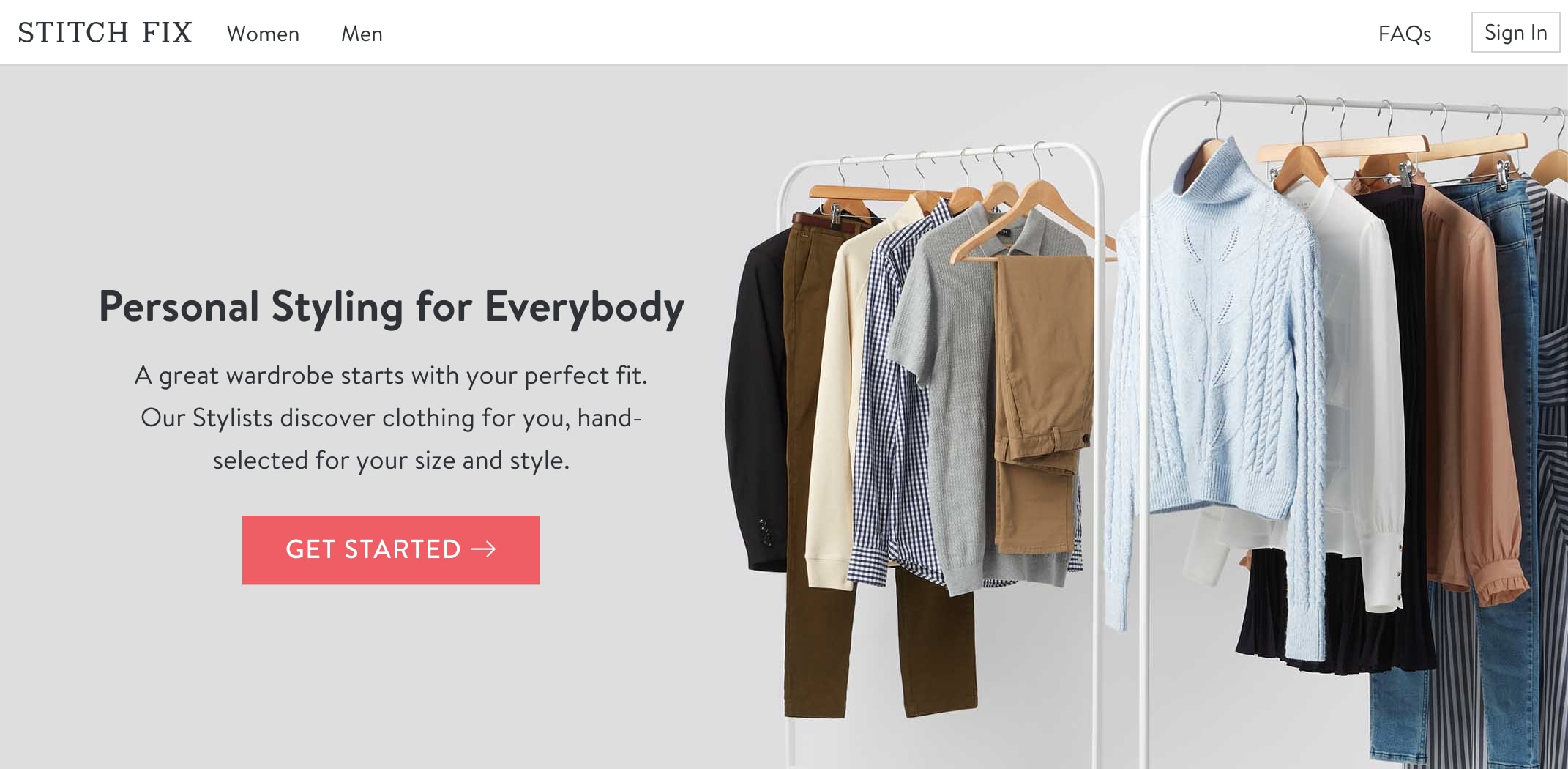
Users provide relevant data about themselves – sizes, style preferences, favourite colours, etc. – and StitchFix analyses this data against the clothing patterns of consumers with similar tastes.
That’s not all, though.
StitchFix also has a team of more than a thousand human personal stylists who assess user profiles and provide expert stylist recommendations. Users then receive their recommendations in the post to try for themselves and they only buy what they like.
Humans and machines, working together in harmony.
As a result, StitchFix delivers a truly personalised customer experience from the very first interaction – and the service only improves as it learns more about individual users.
Why does this work?
StitchFix’s is built from the ground up to deliver personalised experiences that solve some of the most common problems with buying clothes online: size inconsistencies, not being able to try clothes on, items not matching together, etc.
Every customer experience is unique and the quality of recommendations improves over time, as the platform learns more about each customer (data investment), which makes it increasingly difficult for them to abandon it.
What can B2B brands learn from this?
There are plenty of B2B services that could adopt a similar approach to StitchFix. For example, business automation is a tricky concept for companies to adopt and the ideal solution is different for every business.
AI recommendations combined with human expert advice could really help businness choose which tasks to automate and the best tools for each of them.
Likewise, B2B retailers in a wide range of niches could create a similar platform for the companies and individuals who have to make complex purchase choices. Especially if these retailers have an extensive range of stock to browse and choose from or purchase decisions need to consider a complex range of factors (licensing, specs, regulations, etc.).
#4: Solve personal problems
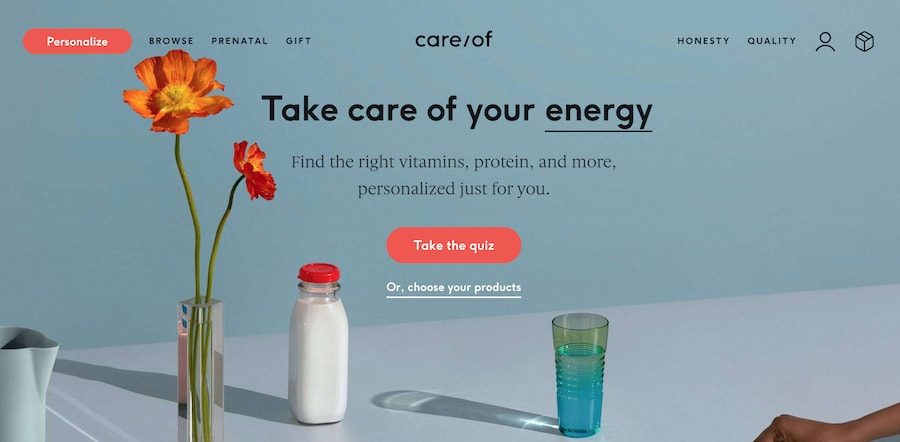
Care/of essentially uses the same business model as StitchFix but, rather than offering up fashion advice, it aims to solve a far more personal problem.
The homepage leads with the following message on its hero section:
Take care of your energy, diet, stress, sleep… life
All users need to do is take a quick quiz and Care/of creates a plan of vitamins and supplements designed to help them feel better and boost their everyday health.
This plan changes as people progress through their initial course and their health reaches certain landmarks – all of which is logged in the mobile app. Users receive new recommendations as their journey progresses and everything is 100% personalised to their unique needs.
Why does this work?
There’s nothing more personal than our own health and Care/of responds to this by creating a 100% personalised and private experience that aims to improve health through preventative measures.
The companies policy of transparency and independent research is also really important here.
We’ll show you the research and be transparent about how established it is. We don’t pretend all supplements have equal levels of scientific evidence or traditional history — because that isn’t the truth. But we will always show our work and tailor our guidance to you as an individual.
It’s not the vitamins and suppliments that peplle are really buying into here. It’s the combined piece of mind and trust thay they’re getting a service which has a genuinely positive impact on their lives, based on their unique health requirements.
That’s what makes this service so personal.
What can B2B brands learn from this?
Businesses don’t have personal problems per se but there’s definitely such a thing as thing business health.
Financial advice, insurance, legal aid, security, marketing and all kinds of other things are essential for maintaining a healthy business and finding the right combination of these individual businesses is much like compiling the perfect vitamin and suppliments plan for people.
Take an insurance firm that offers business protection, for example. Companies need a wide range of cover for public liability, workplace injuries, property, business interruptions and any number of other policies.
The type of business, size of business, locations, regions of operation, number of employees, risk assessment, possibility of public injury and all kinds of other factors determine the combination of insurance required and this could change as businesses grow, evolve, rebrand or relevant regulations change.
B2B services that need to provide tailored packages like this can learn a lot from the Care/of approach to hyper-personalisation.
#5: Make personal stories part of your brand
Back in 2015, easyJet embarked on a hyper-personalised marketing campaign to celebrate its 20th anniversary. In a year when the likes of eBay and FT.com were also marking their 2oth birthday’s, easyJet’s campaign stood out above them all because it put its customers at the heart of its own celebrations.
The multi-channel campaign was centred around TV and social media ads featuring images from easyJet customers on their travels over the previous 20 years. The company later printed these images onto the side of one of its planes and compiled curated “top 20” lists and travel guides from its customers.

A lot have brands have tried to make the most of user-generated personalisation in recent years and many have failed spectacularly. However, easyJet nailed this with its anniversary campaign by aligning its business journey with the best and most memorable moments its customers have enjoyed from its services.
This campaign wasn’t really about easyJet; it was about its customers and this is what the end consumer wants to see from hyper-personalisation.
Why does this work?
Holidays are pretty personal to begin with and we tend to heavily invest ourselves in our memories of past trips and future travel plans. There’s a real strength in the idealistic escapism we associate with travel and easyJet played a major role in making these memories possible for so many people.
The airline was among the pioneers of low-budget flights across Europe, which opened up the travel industry to people who never would have been able to afford such trips – or as many of these trips in their lifetime.
While there are plenty of holes to poke in the customer service delivered by low-budget airlines, without the likes of easyJet many of people’s most precious life memories simply never would have happened – and that’s a powerful message for a company like easyJet to have on its side.
Today, we take the ease of travel for granted but easyJet’s personalised campaign reminds its customers (and everyone else that sees these ads) that their favourite holidays may not have been possible without the company – and it does this by putting them at the centre of the campaign itself.
What can B2B brands learn from this?
The real purpose of easyJet’s campaign was showcasing what the company has done for its customers – not collectively, but on an individual basis. Any B2B brand can take notes from this campaign although easyJet had a golden resource that many businesses don’t have such easy access to.
The key to this campaign was the holiday photos easyJet customers had taken on their travels. Those precious memories, once-in-a-lifetime experiences and idyllic places we all dream of going back to one day. The best part of easyJet is people naturally take these photos when they travel – the content was there, ready and waiting for it.
Your typical B2B brand probably isn’t going to be in the same position where such emotive images and experiences associated with their brand are naturally captured by customers.
If you’ve got them, great – use them.
Otherwise, you can create an environment where landmarks are celebrated. For example, think of a business management software platform that helps business owners set goals and achieve them. Each of those achieved goas is a landmark that can be celebrated with badges, points, scores and other measurements that are displayed in the software platform, constantly reminding users of the progress they’ve made with this piece of software.
This progress can be compiled into monthly and yearly email campaigns, showing users what they’ve achieved during these timeframes. Much like the ease of modern travel, it’s easy to take for granted how much we’ve used a software platform over the years and how much we’ve really done with it.
These campaigns show users the real value of a service and what they wouldn’t have managed to achieve without it. Psychology tells us people the loss of something they already own more than gaining something of the same value that they don’t own (loss aversion).
Campaigns like this are incredibly powerful when it comes to customer retention. And, just like easyJet did, you can compile multiple customer stories into a branding campaign and reach out to new audiences while putting your existing customers in the spotlight.
Time for B2B brands to get hyper-personal
As you can see from the examples we’ve looked at in this article, hyper-personalisation can bring brands and prospects/customers together in genuinely meaningful ways. While its B2C retailers who are driving the innovation in this area, businesses of all kinds have a lot to gain from building these kinds of relationships and it’s time for B2B brands to start implementing hyper-personalisation as a key marketing strategy.




